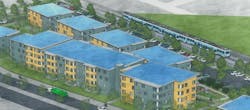New All-Electric California Apartment Community Plans to Harness Microgrid for Off-Grid Living
A new, all-electric apartment complex will break ground in Petaluma, California, in the coming weeks.
With a solar and energy storage microgrid, bidirectional EV chargers and energy efficiency design elements, the 131-unit Meridian at Petaluma North Station will generate and manage all its energy onsite.
The complex is the newest property from Redwood Energy, which bills itself as a zero net energy multifamily housing designer, and Danco, a residential builder, developer and property manager. The two companies have been building apartment complexes together since 2011.
A zero net energy vision
Frustrated with the complexity and time it takes to get new multifamily housing connected to the Pacific Gas & Electric (PG&E) grid, the team set out to develop a zero net energy affordable housing that could operate completely off-grid. The utility has been under fire in recent years from developers who say that causing months-long connection delays jeopardizes the financial viability of their projects.
A zero net energy (ZNE) building produces as much renewable energy as it consumes on an annual basis. Developers typically achieve net energy through a combination of energy efficiency measures and onsite renewable energy generation.
After several design iterations, the team landed on a microgrid that includes a 1-MW solar array consisting of rooftop-mounted panels and solar canopies in the parking lot. A 4.3 MWh battery that could theoretically support the complex for three to four days during inclement weather or power outages is also included.
In an interview with Microgrid Knowledge, Sean Armstrong, managing principal at Redwood Energy, explained that the microgrid’s solar and battery system are designed to allocate about 8 kW of solar capacity per apartment per day and 33 kWh of battery capacity, the equivalent to 2.5 Tesla Powerwalls. The solar array is twice what Redwood would normally design per apartment, but right-sized for winter energy production.
For context, the average detached home in the U.S. requires about 11 kW of solar to meet its daily electricity needs.
To validate performance, the team modeled the system against 25 years of historical weather data, using the worst year on record as the baseline. Even under those conditions, “the system is expected to cover 94% of annual demand, leaving only about three weeks each year where the complex would need supplemental energy,” Armstrong said.
In an average year, he expects performance to be even higher.
Closing the energy gap
Finding the remaining 6% of energy needs was the next challenge for the team. The complex will connect to the PG&E grid, per California law, but the goal is to keep the complex off-grid as much as possible.
Adding more solar panels was not physically possible, so Redwood will install bidirectional EV chargers to cover the potential shortfall.
To support this system, Redwood will integrate a fleet of 30 Chevy Bolts in partnership with Miocar, a nonprofit community car-share program serving low-income households. California Air Resources Board grants, which provide low-income families with access to electric vehicles through car-share programs, will support the integration.
While all the complex’s 142 parking spaces will have an EV charger, 51 will be bidirectional and wired directly into the microgrid. This will allow the car-share EVs to charge from the solar array and battery system and, when needed, discharge electricity back to the building.
Smart, sustainable and affordable living
The seven-building complex is on approximately five acres, adjacent to the newly constructed Petaluma North Sonoma-Marin Area Rail Transit (SMART) train station. There is also a rapid bus transit station nearby.
The three- and four-story buildings will include studio, 1-, 2- and 3-bedroom apartments, as well as a heated swimming pool powered by the microgrid.
A third of the apartments will be supportive housing units designed to provide stable housing for those who have recently experienced homelessness. The remainder will target individuals and families earning between 30% and 60% of the area median income, according to Armstrong.
The all-electric apartments incorporate energy efficiency measures in their design. Three-inch-thick cork panels will serve both as exterior siding and insulation. A wall-mounted heat pump, which Armstrong said proved cheaper to operate and more efficient than ductless splits, will provide heating and cooling.
Electric water heaters and appliances are also included.
Gray water will be filtered and treated with a UV sterilizing light to safely irrigate the property’s landscape – which will be all edible.
A model for off-grid affordable housing
Meridian, formerly known as Corona Station, is being developed as part of a research project managed by the Electric Power Research Institute (EPRI).
Funding for the microgrid’s construction is coming from a $9 million grant from the California Energy Commission, as well as other state rebates and incentives. EPRI received the grant and brought Redwood Energy on as the microgrid designer.
Armstrong expects the first residents will be able to move in within 18 to 24 months.
Earlier this month, Thrive Collaborative announced a similar all-electric residential community in Ann Arbor, Michigan, that includes 50 affordable housing units.
About the Author
Kathy Hitchens
Special Projects Editor
I work as a writer and special projects editor for Microgrid Knowledge. I have over 30 years of writing experience, working with a variety of companies in the renewable energy, electric vehicle and utility sector, as well as those in the entertainment, education, and financial industries. I have a BFA in Media Arts from the University of Arizona and a MBA from the University of Denver.


